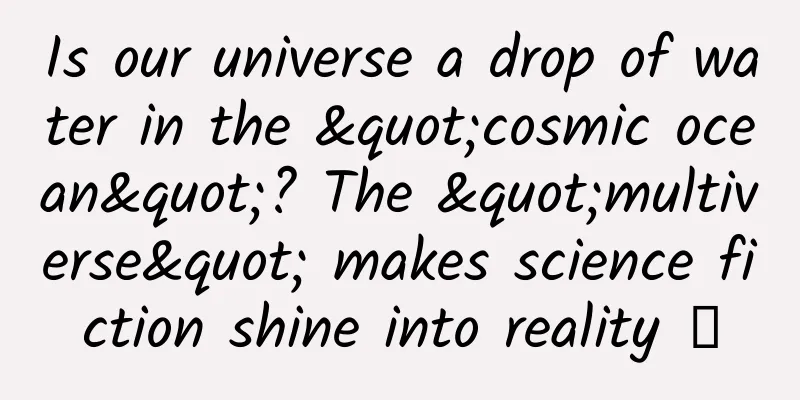Is our universe a drop of water in the "cosmic ocean"? The "multiverse" makes science fiction shine into reality →

|
Author: Duan Yuechu and Huang Xianghong On August 14, 2024, according to Scientific American, Sarah Scholes and Sid Gandrizadeh published their research views on the multiverse. It is an indisputable fact that human beings live in the universe. However, a thought-provoking question emerges: Is the universe we live in just a drop of water in the ocean of many universes? The concept of the multiverse is not only a fascinating theme in science fiction, but also a real possibility that is seriously studied by some scientists in modern physics. A host of novel concepts are emerging in many branches of modern physics. In quantum mechanics, a particle can exist in a superposition of all possible states at once, until someone tries to measure it. At this point, the possibilities collapse, and a clear physical state emerges before the observer. The "many-worlds interpretation" of quantum mechanics assumes that all possible states that a quantum measurement might reveal occur in different universes, each with its own different observer. This interpretation may be the most famous view of the multiverse in science, but it is by no means the only one. In his new book, The Lure of the Multiverse: Extra Dimensions, Other Worlds, and Parallel Universes, Paul Halpern delves into these potential parallel realities, including their history, philosophical implications, and insights into the nature of science. Scientific American spoke with Halpern about how the concept of the multiverse fits in with modern physics, the evidence scientists have so far, and what it all means for the nature of our existence. So, what exactly is the multiverse? From a scientific perspective, the idea can be divided into the quantum multiverse and the cosmic multiverse. The quantum multiverse is a possible answer to the question of what happens when you make a measurement in quantum physics, and how human life relates to the quantum world. It was proposed by a young graduate student Hugh Everett III in 1957, and it speculated that different possibilities would split into different universes, and humans would experience multiple realities without knowing their own "duplicates". The cosmological multiverse is related to a concept called "inflation". In the early stages of the universe, this rapid expansion was relatively easy to achieve and has been happening all the time, leading to other bubble universes that continue to expand, including our own. It's just that they are currently beyond our observation range. Some parameters of our universe seem to be just right, in the right range for the formation of galaxies, stars, planets, and life. If these constants, such as the strength of gravity and the strength of electromagnetic interactions, were slightly different, planets and life as we know them would never have been born. This is called the "fine-tuning problem." Physicist Brandon Carter proposed around 1970 that perhaps our region of the universe, or even the entire universe, is special. Perhaps we should consider all the other possibilities and think about why we are in this branch of the universe and not others. It may be related to the fact that there is a range of possible universes, and we happen to be in a small number of universes that can support the formation of structure and eventually give rise to life as we know it. However, in most other versions of the universe, we would not exist. However, a tricky problem is that even if other universes exist, they are beyond our perception. Scientists currently have no way to directly test the idea of the multiverse. Although in the book, Halpern proposes some indirect testing ideas and points out that some clever direct experiments may be thought of in the future, for now, the multiverse is untestable. In physics, there are other ideas that can never be directly verified. For example, the universe is expanding and accelerating, and because the speed of light is limited, we can never see parts of the universe beyond a certain radius (about 46 billion light-years). Quantum uncertainty also limits what we can observe at one time, and Heisenberg's uncertainty principle makes it impossible for us to simultaneously describe the position and momentum of all particles in the universe, even in theory. This brings up a key question: Is the goal of science to try to find out the truth about the universe, or is it just to find things that can be proven experimentally? Humans have always been committed to understanding the world they live in and the universe as a whole. We use a variety of tools, including theoretical physics and direct observation. Although we hope that the two will match each other, sometimes there is a lag. Sometimes there are experimental results that cannot be explained by theory, and sometimes some theoretical models can be accepted to a certain extent without observations, and only later do scientific experimental results come out. Ideas that are exciting in theory often need time to be tested. When different physicists were asked about their attitudes towards the multiverse, the results were surprising. Some scientists who are considered observation-based and hard-headed are open to the idea of the multiverse, while others with more far-reaching ideas draw the line and reject the concept of the multiverse. Different theorists have their own preferences, and there is a certain amount of personal philosophy involved. Even for professionally trained physicists, there is still room for philosophical preferences based on following the laws of physics and general relativity and quantum physics. Through this series of discussions, author Sarah Scholes hopes that people can understand the various possibilities in theoretical physics, even those widely accepted theories such as general relativity and quantum physics, and understand how they are somehow integrated into the huge mystery of the universe we observe today. In the face of so many possibilities, why things have developed into the way they are now is still a mystery to be solved. In short, the concept of the multiverse opens a window for us to peek into the unknown, allowing us to have deeper thinking about the nature of the universe and human existence. |
<<: It clearly looks like a big "rat", so why is Capybara so popular?
>>: Latest research: Garlic can really lower blood lipids and blood sugar, but the premise is...
Recommend
The college entrance examination is approaching. How can parents provide good logistical support?
...
13 billion liters of water disappeared? Freshwater lake suddenly turned into saltwater lake? What happened?
At the end of the last century, Lake Pinnell in L...
How to systematically make a competitive product analysis report?
The author starts with the concept of competitive...
The most powerful bird of prey turns out to be a big bald man?
Around 3500 BC, a large number of humans migrated...
The latest news on Zhengzhou’s unblocking in 2022: Can the main urban area be unblocked on May 10? Attached is the latest official response
This round of local epidemic in Zhengzhou was dis...
Major adjustment: Apple will allow one-click rating and reply to user reviews
At the end of January, Apple announced a major ne...
How to make users believe in your product?
Before users buy a product, their biggest concern...
What are the characteristics of influenza A? Should antiviral drugs be used? Expert answers
Xinhua News Agency, Beijing, March 13th , Title: ...
Zhang Yanhua sells goods through live streaming, and can earn over 100,000 yuan a month from her side job starting from scratch
Zhang Yanhua sells goods through live streaming. ...
How to identify pharmaceutical advertisements?
Drug promotion activities can be identified as dr...
Industry promotion is undergoing transformation: 30% of companies that buy traffic no longer do so!
Recently, the author went to Shenzhen to attend a...
Daokun "Taobao Blue Ocean Profitable Non-standard Product Selection Ideas" Daokun Taobao Internal Training Club [2021], worth 4980 yuan Baidu Cloud Download
Dao Kun Taobao Blue Ocean Internal Training is a ...
Solid info! How to realize the monetization of the three major online advertising and its development trend
The current profit models of the Internet industr...
Why do we say “third-rate plays with products, second-rate plays with traffic, and first-rate plays with users”!
There has always been a tradition in Zhihu, which...









